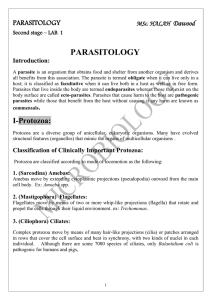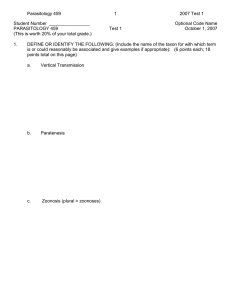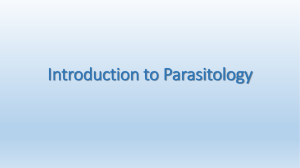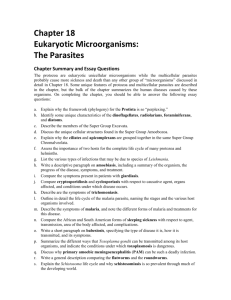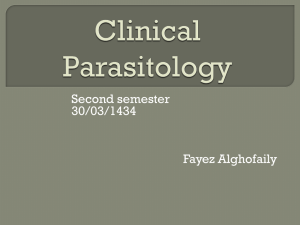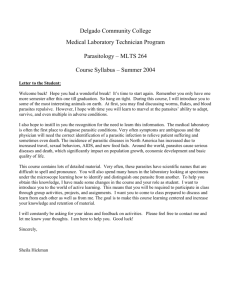Introduction to Parasitology
advertisement
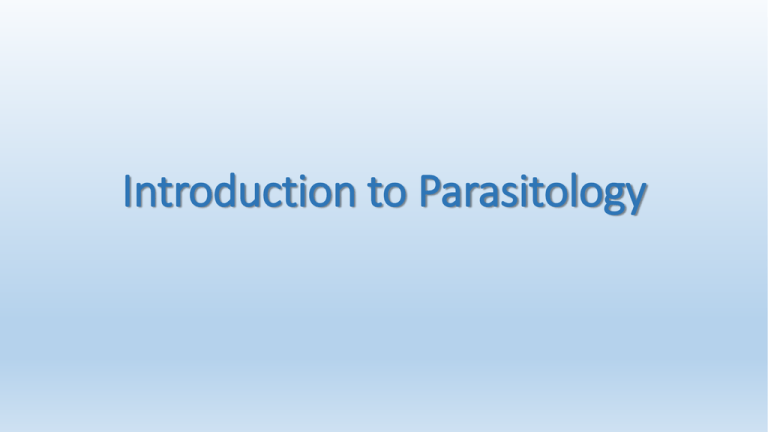
Introduction to Parasitology What is Parasitology? A parasite is an organism that live on or within another organism called the host . Parasitology is a science of studying parasitism and a discipline dealing with the biology of parasites (including its morphology, embryology, physiology, biochemistry and nutrition, etc.), ecology of parasitism with emphasis on parasite-host and parasite-environment interactions. • the parasites studied in this discipline involve parasitic protozoa, parasitic helminthes, certain lesser groups of worms, parasitic arthropods, and the vectors of parasites, that is, parasitology is largely an amalgamation of protozoology, helminthology, entomology and acarology. • Parasitology has also been subdivided into medical or human parasitology, veterinary parasitology, fish parasitology and plant nematology What is Medical Parasitology? Medical parasitology or human parasitology is restricted to studying those parasites that are living in or on the body of humans and with aspects of the host-parasite relationship having medical significance. In other words, medical parasitology is the subject which deals with the parasites that infect man, the diseases caused by them, clinical picture and the response generated by man against them. Medical Parasitology Parasitic diseases Parasites Prevention Transmission Treatment Diagnosis Pathogenesis Life Cycle Morphology Medical parasitology Medical protozoology Medical helminthology Medical arthropodology i.e. Medical entomology Medical Parasitology in Medical Education Public Health & Preventive Medicine Clinical Medicine Medical Parasitology Biology,Biochemistry,Anatomy, Histology,Physiology,Immunology History of Human Parasitology Early written records • 3000 to 400 BC, the first written records of parasitic infections come from Egyptian medicine, particularly the Ebers papyrus of 1500 BC discovered at Thebes. Intestinal roundworms and tapeworms. • 800 to 300 BC, writings of Greek physicians such as Hippocrates. Worms from fishes, domesticated animals, and humans. • 3000 to 300 BC, writings of physicians from China. • 2500 to 200 BC, from India. • 700 BC to 400 AD, from Rome. • Latter part of the first millennium, from the Arab Empire. • Arabic physician Avicenna (AD 980 to 1037) , wrote important medical works that contain a great deal of information about diseases clearly caused by parasites. He recognized not only Ascaris, Enterobius, and tapeworms but also the guinea worm, Dracunculus medinensis. History of Human Parasitology Modern times • Manson in 1879 filariasis • Laveran in 1880 malaria parasite • Ross in 1897 malaria life cycle • Bruce in 1896-1902 and Chagas in 1908 trypanosomiasis • Leishman and Donovan in 1900-1911 leishmaniasis …… • 1879 (Ringer) , 1880 (Manson) : Paragonimus westermani • 1875 (McConnell) : Clonorchis sinensis • 1905 (Logan) : Schistosoma japonicum in China Patrick Manson(1844-1922) “Father of modern tropical medicine” In England Manson became Medical Advisor to the Colonial Office and in this capacity persuaded the then Secretary of State for the Colonies, Joseph Chamberlain, of the need for providing facilities in Britain for educating doctors in tropical diseases. One consequence of his influence was the creation of School of Tropical Medicine in both Liverpool and London in 1898 The first President (and Ronald Ross Vice-President) of the Society of Tropical Medicine and Hygiene (1907) The first to discover (1877–79) that an insect (mosquito) can be host to a developing parasite (the worm Filaria bancrofti) that is the cause of filariasis 1907 Nobel Laureate in Medicine in recognition of his work on the role played by protozoa in causing diseases Alphonse Laveran 1902 Nobel Laureate in Medicine for his work on malaria, by which he has shown how it enters the organism and thereby has laid the foundation for successful research on this disease and methods of combating it Ronald Ross Conceptions related to medical parasitology • Symbiosis • Parasite and type of parasites • Host and common type of host • Life cycle and type of life cycle Symbiosis The relationship between two living things (animals). Two living things live together and involve protection or other advantages to one or both partner. • Commensalism • Mutualism • Parasitism Commensalism Both partners are able to lead independent lives, but one may gain advantage from the association when they are together and least not damage to the other A female pea crab in the mantle cavity of its mussel host. The crab does not damage the mussel and uses its shell purely for protection Mussel Mutualism An association which is beneficial to both living things A selection of ciliates from the rumen of cattle or sheep. The rumen contains enormous numbers of ciliates that break down cellulose in the feed Parasitism An association which is beneficial to one partner and harmful to the other partner. The former that is beneficial to is called parasite, the latter that is harmful to is called host. e.g., Human / Hookworm Anterior end of a hookworm Other classification Parasites may be classified according to different ways: Obligate parasite: a parasite which cannot survive in any other manner, e.g., filaria Facultative parasite: an organism which may exist in a free-living state and which if opportunity presents itself may become parasitic, e.g., Strongyloides stercoralis Endoparasite and ectoparasite A parasite which lives in or on the body of the host is called endoparasite (protozoa and helminthes) or ectoparasite (arthropods) Host and type of host Host : an organism that harbors the parasite usually larger than the parasite • Intermediate host : the host harboring the larvae or asexual stage of parasite • Final host (definitive host) : the host harboring adult or sexual stage of parasite Host and type of host • Reservoir host : animals harboring the same species of parasites as man, e.g., schistosome/human, buffalo Potential sources of human infection • Paratenic host (transport host) : a host which acts as a transporting agent for the parasite and in which, the parasite, usually a larval stage, dose not undergo any further development but if they could go into a final host by accident it would continue to develop till sexual maturity, e.g., Paragonimus Westermani /human. Life cycle and type of life cycle Life cycle : the whole biological course of growth, development and reproduction of a parasite • The direct type : only one host (final host, no intermediate host). e.g., Ascaris lumbricoides, Hookworm, and Enterobius vermicularis • The indirect type : life cycle with more than one host (intermediate host and final host) . e.g., plasmodium, lymphatic filaria Classification of parasites Protozoa (Unicellular) Nematodes Trematodes Parasites Helminthes Cestodes (Multicellular ) Arthropods (Ectoparasite) (Endoparasite) Protozoa Plasmodium RBC PROTOZOA • Amebae (found in stool) • • • • • Entamoeba coli Entamoeba histolytica Endolimax nana Iodamoeba butschlii Dientamoeba fragilis • Flagellates (found in stool) • Giardia lamblia • Chilomastix mesnili • Ciliates, Coccidia, Blastocystis • Balantidium • • • • • • Cryptosporidium Isospora belli Sarcocystis Cyclospora Microsporidium Blastocystis hominis • Blood-Borne Protozoa • • • • • Babesia Leishmania Trypanosoma brucei T. cruzi Plasmodium • Other • Toxoplasma • Naegleria fowleri • Acanthamoeba Intestinal and luminal protozoa significant to human health include • Entamoeba histolytica (Amoebae) • Balantidium coli (Ciliates) • Giardia lamblia and Trichomonas vaginalis (Flagellates) • Cryptosporidium parvum and Isospora belli (Sporozoa) Protozoa Found in Stool: Amebae pathogen Entamoeba histolytica/dispar • E. histolytica is a pathogen and E. dispar is a nonpathogenic species that can also occur in the large intestine. Morphologically indistinguishable • E histolytica • Cysts = infectious form • trophozoites = invasive form • Contaminated water and poor sanitation • Colon biopsy shows “flask-shaped” ulcer • Non-intestinal disease = extraintestinal amebiasis (liver abscess) • Serology Entamoeba histolytica/dispar Cysts <= 10 um In diameter Up to 4 nuclei in the cyst Clean chromatin Bulls-eye nucleoli Amebic abscess Amebic liver abscess Entamoeba histolytica Serology – high % positive in extraintestinal cases Flask-shaped ulcer of intestinal amebiasis Entamoeba histolytica/dispar Trophozoites & Trophozoite with ingested rbcs Cysts Entamoeba coli Trophozoites & Cysts Entamoeba coli cyst and trophozoite Trophozoite is the form that invades intestines Cyst >=15 mm Up to 8 nuclei Shed from host Lives in environment Nucleus has a chromatin ring The cytoplasm appears dirty Protozoa Found in Stool: Flagellates Giardia lamblia • Contaminated water, undercooked foods • Mild diarrhea to severe malabsorption • Foul, watery diarrhea • Day-care center outbreaks • Cysts/trophozoites may be seen in stool, but can be hard to find; Fluorescent stains available • Duodenal aspirations CYSTS TROPHOZOITE “falling leaf” motility Giardia lamblia trophozoite Waxing and waning symptoms Can be irregularly Shed in stool material & can be difficult to find Russia & Mexico -Hot beds Only invades intestine Flagyl (Metronidazole) is drug of choice Giardia lamblia cysts Giardia lamblia cysts Giardia lamblia trophozoites Trichomonas vaginalis • Urogenital protozoan • Scant, watery vaginal discharge • Four flagella, short undulating membrane Protozoa Found in Stool: Ciliates, Coccidia, Blastocystis Ciliates • Balantidium coli • • • • • Mainly in swine Contact with swine & poor hygiene Only ciliate that’s pathogenic to humans Similar disease as amebiasis, but extraintestinal invasion rare Largest (50-200 um) trophozoite; surface covered with cilia; macronucleus • Cyst 40-60 um • Readily identified in fresh, wet mounts Only protozoa with cilia 50 microns In intestine can cause flask-shaped ulcers like those caused by E. histolytica Blood-Borne Protozoa Organism Trypanosoma brucei T. cruzi Leishmania donovani Babesia microti Transmission Tsetse fly Reduvid (kissing) bug Phlebotomine sandfly Ixodes tick Disease/Sympto ms African trypanosomiasis; Sleeping sickness Encephalitis; cardiac failure Diagnosis Treatment Hemoflagellate in blood or lymph node Blood stage: Suramin or petamidine isethionate American trypanosomiasis; Chagas disease: megacolon, cardiac failure. Hemoflagellate in blood or tissue. C- or commashaped CNS: melarsoperol Nifurtimox and Benzonidazole. Visceral leishmaniasis (Kalaazar), granulomatous skin lesions Iraq/Iran/Afghanist an Hemolytic anemia, Jaundice, fever, hepatomegaly Intracellular (macrophages) leishmanial bodies with kinetoplast Pentosam; Pentamidine isethionate. Maltese cross in rbc None; self resolving. Trypanosomes • 2 different diseases • Chagas disease (American trypanosomiasis) • Trypanosoma cruzi • Reduviid / Triatome (kissing) bug • African sleeping sickness (African trypanosomiasis) • T. brucei (gambiense and rhodesiense) • Tsetse fly Trypanosoma brucei Sleeping sickness (African trypanosomiasis) • Vector: Tsetse fly • The two T. brucei species that cause African trypanosomiasis are indistinguishable morphologically • T. b. gambiense • T. b. rhodesiense • A typical trypomastigote has: • A small kinetoplast located at the posterior end • A centrally located nucleus • An undulating membrane, and • A flagellum running along the undulating membrane, leaving the body at the anterior end • 14 to 33 µm in length • Trypomastigotes are the only stage found in patients. Trypanosoma brucei gambiense in a blood film Filamentous structures found in blood TRYPANOSOMA GAMBIENSE Leishmania • Obligate intracellular parasite • Vector: female sand fly bite • Visceral leishmaniasis (kala azar) • L. donovani • Cutaneous leishmaniasis • L. tropica • L. braziliensis Leishmania • Leishmania amastigotes • Macrophages filled with amastigotes (arrows), several of which have a clearly visible nucleus and kinetoplast • Amastigotes are being freed from a rupturing macrophage Leishmania – Clinical Disease • Cutaneous • Single or few chronic, ulcerating lesions; many species • Latin America, southern Europe, Middle east, southern Asia, Africa • Mucocutaneous in Latin America • Visceral • primarily L. donovani complex (Asia), L. infantum/chagasi (Africa and Latin America), others • Hepatosplenomegaly, anemia, cytopenias, systemic symptoms • India, Bangladesh, Nepal, Sudan, and Brazil • Important OI in HIV infection Leishmania donovani Skin lesion Sand Fly Kinetoplast next to nucleus MALARIA • Protozoan • Transmitted by the anopheles mosquito • Endemic to tropical areas Malaria Symptoms • Fever and chills • Splenomegaly • Headache • Abdominal pain • Diarrhea • Myalgia • Blackwater fever (hemolysis, hemoglobinuria, renal failure) – P falciparum only Malaria • Distinction is between P. falciparum and non-falciparum • P. falciparum = rapidly progressive and LETHAL (malignant tertian fever), often chloroquine-resistant • Non-falciparum = rarely cause severe manifestations, often chloroquine sensitive • Relapsing malaria • Dormant hepatic phase • Hypnozoites of P. vivax and P. ovale MALARIA Life Cycle of Plasmodium Species Malarial Preparations Thick smear Thin smear Drop of blood on slide • Water rinse to eliminate • rbc’s Stain with Giemsa stain (not • Wright-Giemsa) with proper pH Concentrated to spot malaria • parasites • Feather edge smear • For optimal morphology, stain with Giemsa (not Wright-Giemsa) stain with proper pH • Speciation of malaria • Parasitemia (%) Malaria Diagnosis • Microscopy is most often used • Antigen detection – EIA available • Molecular methods “Rosette” schizont Other Protozoa • Toxoplasma Organism Toxoplasma gondii Transmission Oral from cat fecal material or meat Disease/Symptoms Adult: flu like; congenital: abortion, neonatal blindness and neuropathies Diagnosis Intracellular (in macrophages) tachyzoites Treatment Sulphonamides, pyemethamine, possibly spiramycin (nonFDA) Toxoplasma gondii • • • • Coccidian protozoan House cat = definitive host Ingestion of infective oocysts from contaminated cat feces Ingestion of improperly cooked meat from animals that serve as intermediate hosts (rodents) • Symptoms • Predilection for lung, heart, lymphoid organs, CNS/eye • Infectious mono-like; lymphadenitis, hepatitis, rash, encephalomyelitis, myocarditis, chorioretinitis • Transplacental infection • 1st trimester spontaneous abortion, stillbirth or severe disease • 2nd/3rd trimester CNS infections (epilepsy, encephalitis, intracranial calcifications, MR, chorioretinitis, blindness, hearing loss), jaundice, rash • AIDS - Encephalitis; mass lesions in brain Toxoplasma gondii • Diagnosis • Serology EIA • Anti-toxo IgM – congenital and acute infection; may persist for months • Anti-toxo IgG – common; if positive, gestations safe from intrauterine toxoplasmosis infection • PCR Toxoplasma gondii Can be diagnosed by serology Toxoplasma gondii • Toxoplasma gondii cyst in brain tissue stained with hematoxylin and eosin HELMINTHS • Nematodes (roundworms) • Trematodes (flukes) • Cestodes (tapeworms) Nematodes • Enterobius • Ascaris • Trichuris • Necator and Ancylostoma (Hookworm) • Microfilaria – Wucheria, Brugia, Loa loa, Mansonella, and Onchocerca Enterobius vermicularis (pinworm) • Humans considered only host • Females 8-13mm, males 2-5 mm • Dwell in the cecum • ¼-1/2 inch in thickness, white, lloks like string in stool • Lay up to 15,000 eggs • Oval with a flattened side: 50-60um by 20-30um • Diagnosis- Scotch tape test or anal swab • Most common helminth in US Enterobius vermicularis (pinworm) eggs Asymmetrical eggs Pinworm larvae Ascaris lumbricoides (roundworm) • 1-1.2 billion people infected • More common in children • 20,000 death • Largest helminth to affect humans • Females 20-35cm long, males 15-30cm with a curved tale • Can cause intestinal obstruction Ascaris lumbricoides Ascaris eggs Unfertilized eggs-large & oval, mammillated layer is pronounced Fertilized eggs- smaller, rounder, mammillated layer is less obvious Trichuris Trichiura (whipworm) • Soil transmitted • Can be similar to amebiasis • PVA preserved samples inferior to formalin • Adults attach to large intestine and are rarely recovered • Thinnest part- head • Males are smaller than females Trichuris trichiura Necator americanus, Anclyostoma duodenale (Hookworms) • Soil transmitted • 2nd most common helminth infection • Enter via exposed skin Necator or Ancylostoma – Hookworm egg Trichinella spiralis -Tissue nematode -All stages occur in single host -usually an incidental finding in muscle Loa loa (eye worm) Trematodes (Flatworms) • Intestinal and Liver flukes • Fasciolopsis buski • Fasciola hepatica • Liver flukes • Clonorchis sinensis (Chinese liver fluke) • Paragonimus westermani – oriental lung fluke • Schistosomes • S mansoni – intestinal bilharziasis • S haematobium - urinary • S japonicum – blood fluke, found in intestines Trematodes ( Flukes ) Schistosomes Schistosoma japonicum, mansoni Fasciolopsis buski ( Giant intestinal fluke) Distinct nose Fasciola hepatica Fasciolopsis buski Fasciola hepatica Fasciolopsis buski Fasciolopsis buski Cestodes (Tapeworms) Flattened dorsoventrally, segmented Head with armed or unarmed scolex Proglottids immature, mature (sex organs) Gravid (with eggs) • Examples Internal structure of proglottids Hermaphroditic-ovary, testes, vitellaria, uterus, genital pore and ducts • Taenia solium Lateral excretory and nervous system No gut-tegument absorbs nutrients Muscles-longitidinal and horizontal • Diphyllobothrium latum • Taenia saginata • Hymenolepis nana • Hymenolepis diminuta • Echinococcus granulosis Diphyllobothrium latum • Poorly-cooked fresh-water fish(salmon) • Scandinavian, Russia, Canada, N. USA, Alaska • Broad fish tapeworm • Longitudinal sucker • Eggs have non-shouldered operculum and knob • They are not embryonated • Causes Vit B12 deficiency Diphyllobothrium latum Sucking plate Diphyllobothrium latum Taenia Species – two species Outstanding characteristics Taenia saginata Taenia Solium Beef tapeworm 4 suckers on scolex >13 uterine branches in proglottids Ingestion of cysticerci in beef Intestinal infestation Ingestion of eggs -> Non-human pathogen Pig tapeworm Ring of thorns/crown on scolex <13 uterine branches in proglottids Ingestion of cysticerci in pork Intestinal infestation Ingestion of eggs -> Cysticercosis Taenia eggs Identical eggs for the two species Taenia saginata Proglottid > 12 uterine branches Taenia solium Scolex - Ring of thorns Proglottis – fewer uterine branches (<=12 uterine branches) Medical arthropods Fly Sandfly Mosquito Soft tick Louse Flea Hard tick Medical arthropod: These arthropods related to human health. Medical arthropodology: A science that study the morphology, taxonomy, life cycle, zoology, geographic distribution of medical arthropoda, and the relationship of medical arthropods with the transmission of the disease, as well as the measures for medical arthropods control. General Characteristics • metamerism (segmented body) • jointed appendages • bilateral symmetry • secreted exoskeleton • ecdysis (molting) • open circulatory system • ventral nerve cord and brain characteristics • 3 body segments- head, thorax (chest), abdomen (stomach area). • Insect means in (into) sect (cut). Arthropods affect the health and well-being of humans and animals in several ways: •Direct Causes of Disease or Distress •Vectors or Hosts of Pathogenic Organisms •Natural Enemies of other medically harmful insects Direct Causes of Disease or Distress: •Ectoparasites - ticks, fleas, mites •Endoparasites - chigoe flea, myiasis •Envenomization - wasps, bees, spiders •Allergic Reactions - dust mites •Annoyance - mosquitoes, black flies •Delusory parasitosis (DP) - psychosis Vectors or Hosts of Pathogenic Organisms: • Arthropod serves as intermediate host and vector of pathogenic microorganisms • Vectors and hosts - bloodfeeding • Hosts only - no bloodfeeding Natural Enemies of other medically harmful insects: • Mites parasitic on mosquitoes • Fire ants consume tick eggs Insect Growth Basics • Insects develop from egg. Eggs come in a variety of shapes and sizes. • They hatch from the egg, and begin eating • Sooner or later they become too big for their exoskeletons. • They Molt , or shed their skins. Molting is the shedding of old cuticle and expanding into a new and larger one. • Changes in the insect may occur with each molt. This is called metamorphosis , or a change in form. Types of Metamorphosis • Partial metamorphosis (gradual, incomplete) • Complete metamorphosis most advanced Incomplete Metamorphosis • Gradual change in appearance. For example, wing pads grow longer with each molt, and eventually into wings in the adult. • Immature forms are called NYMPHS • Generally have the same food source as the adult. LIFE CYCLE OF A GRASSHOPPER (CLASS INSECTA ORDER ORTHOPTERA) Complete Metamorphosis • Immature is called a larva , with larva perhaps having separate food source from the adult. • Larva and adult may have radically different food sources,with very different environments. • Example: Butterflies. Or, they may have same food source: bees. (Larva) Caterpillar (Pupa) Chrysalis LIFE CYCLE OF A BUTTERFLY (CLASS INSECTA ORDER LEPIDOPTERA) Harmful effects of arthropods 1. Direct harm a. Annoyance-flies interfere with your work and rest. b. Venom-stings of scorpions and spiders may even cause death. c. Parasites-Fly larvae may cause myiasis, scabies and mange are caused by Sarcoptes scabiei. Harmful effects of arthropods • 2. Transmission of diseases: a. Mechanical transmission. b. Biological transmission. Pathogens spend a part of their life cycle in the arthropods. a) Propagative b) Cyclopropagative c) Cyclodevelopmental c. Transovarian. • b) Cyclopropagative-The pathogenic organisms undergo a developmental cycle in the arthropod with multiplication and change in form. Plasmodium sp. In anopheline mosquitoes. • c) Cyclodevelopmental- The pathogenic organisms undergo a change in form without multiplication. Filaria in mosquitoes. Ticks of importance Hard Ticks Soft tick Expands with blood engorgement Ticks, Mites and Associated Pathogens • Characteristics of the order Acari (ticks and mites) • Metastigmatid mites = ticks • MANY tick-borne pathogens… • Mesostigmatid mites, prostigmatid mites and astigmatid mites • Infestation, allergy, scrub typhus, rickettsialpox 123 Body louse Body Louse Hair nit Flea Crab louse • Lice are spread from human to human most often by direct contact or contact with contaminated clothing, etc. Body lice are restricted most often to the human body and head (some authorities believe the head louse is a separate species). Crab lice are most often restricted to the pubic region, but may spread to the armpits, facial hair (beard, etc.), eyebrows, and eyelashes. Infestations with lice are not a serious problem (as long as the lice are not infected with a disease), but they can cause a number of uncomfortable symptoms, including skin irritations and intense itching. • Pediculus humanus, the human body louse (approximate length = 2 mm). • A crab louse attached to a hair. • A "nit" or egg of Pediculus humanus. SCABIES SARCOPTES SCABIEI Mite Scabies Tiny eggs under skin Common infestation locations Life cycle of the scabies mite Scabies Signs and Symptoms • Pruritus of skin • Intense scratching especially at night • Papular rash Scabies Burrows (arrows point to mites) Dermatophagoides 135 House Dust Mites - Dermatophagoides • The term 'house dust mites' is used originally to refer to those mites belonging to Pyroglyphidae. At present, the term 'dust mites' is widely used instead and this is in reference to all pyroglyphid and nonpyroglyphidites that are implicated in dust borne respiratory allergy. • House dust mites cause 25% of all allergies and 50% of all asthmatic diseases are traceable to house dust mites 136 MOSQUITO The life cycle of mosquito The complete life cycle contains eggs, larva, pupa and adult. All mosquitoes require water for the development of the larvae and pupae, but the adults live in land. Control 1) Larva control Chemical control, e.g., insecticide is placed in the water; biological control, e.g., predators, disease agents; source reduction or habitat management. 2) Adult control Insecticides (direct action and residual action); Personal protection. THANK YOU
